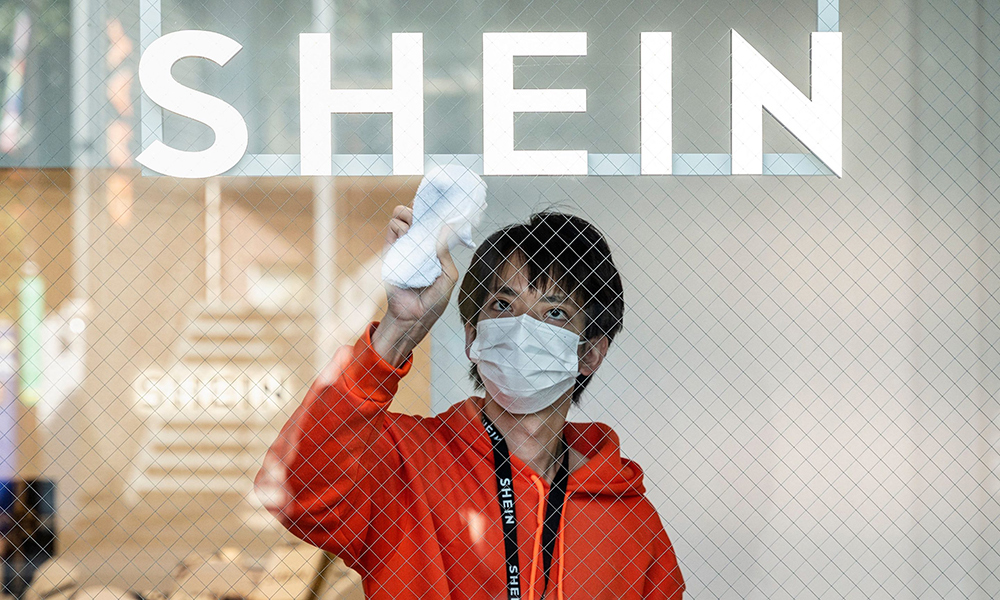
電商巨頭希音(Shein)將走出其賴以成名的時尚和服裝領域,開拓其他領域的市場。在這一過程中,它與另外一個家喻戶曉的在線市場平臺變得越來越像。
據路透社(Reuters)于4月30日報道稱,希音正在尋求與更多品牌合作,包括日用品巨頭高露潔-棕欖(Colgate-Palmolive)、玩具廠商孩之寶(Hasbro)和化妝品牌等,希望它們通過希音平臺出售商品。希音平臺以經濟實惠的時尚服裝而成名,但也引起了外界對其用工和環境影響方面的擔憂。它正在采取措施打造一個包羅萬象的平臺。
據路透社報道,在4月17日于法國巴黎舉辦的一個會議上,希音的歐洲、中東與非洲品牌運營高級總監克里斯蒂娜·芳塔娜表示:“所有人都會將希音與時尚相關聯,但我們正在開拓所有垂直領域。”
她補充道:“我們的消費者希望看到所有品牌,[因此]消費者想要什么,我們就要滿足他們的需求。”
美國加州大學伯克利分校(University of California at Berkeley)的經濟分析與政策教授史蒂夫·塔德雷斯對《財富》雜志表示,希音的擴張顯然是搶占電商領域更多市場份額的一種策略。
希音在美國快時尚市場占據最大市場份額,2023年的年利潤較前一年翻了一番,達到20億美元。希音計劃進行首次公開募股,估值高達900億美元。雖然與亞馬遜(Amazon)在美國電商領域38%的市場份額相比,希音零售帝國的規模仍然遜色不少,但塔德雷斯稱,希音將以行業領先者為目標奮起直追。
他說:“面對世界各地對亞馬遜的監管,以及認為需要對亞馬遜的壟斷加以控制的討論,希音現在開始搶占亞馬遜的份額,甚至未來可能搶占更多份額,這并不意外。”
大獲成功的希音
來自中國的快時尚平臺希音,由億萬富翁許仰天創立于2008年。該平臺大獲成功,通過其大規模高效生產和經銷策略,月用戶數量高達4,500萬。
希音利用人工智能和電子監控,能夠識別網絡趨勢,并反饋給供應商進行小批量生產,然后根據初步銷售數據決定是否大規模生產一款產品。該系統幾乎保證了該公司可以準確把握市場趨勢,并快速推出商品,但它也因為侵犯版權、數據爬取以及假冒商品泛濫等指控而陷入困境。
盡管歐盟委員會(European Commission)等監管機構試圖制衡該公司,以阻止其可疑的商業行為,但希音可能已經找到了規避監管的方法。
哈佛商學院(Harvard Business School)的名譽教授約翰·戴頓告訴《財富》雜志,希音吸引更多品牌加入其平臺的策略,只會幫助該公司躲過外界的更多關注:該平臺上很快就會有成千上萬種消費者熟悉和信賴的商品,例如高露潔牙膏和培樂多(Play-Doh)彩泥等,這從本質上是在告訴監管機構這里沒有值得關注的問題。
戴頓表示:“它們不會受到監管機構的審查。”
與亞馬遜競爭
塔德雷斯指出,希音這種隱居幕后的方法,使其向時尚之外的領域擴張,變成了合理的下一步措施。憑借高效的基礎設施,希音能夠更加靈活地向服裝以外的領域擴張。
他補充道:“我真的認為這是一種明智的商業決策,即‘我們有出色的物流網絡,首先讓我們將其向可以采購到廉價商品的其他領域擴張。’”
市場調研平臺AlphaWatch.AI的科技分析師兼首席運營官馬睿對《財富》雜志表示,希音在服裝領域的穩固地位,讓它在與亞馬遜的競爭中獲得了另一個優勢。馬睿指出,眾所周知,時尚是一個“挑剔”的行業,而且盡管亞馬遜同樣涉足了服裝領域,它卻未能像希音一樣成功。
她說:“歷史上,供需匹配的難度極大。這并不是一個特別容易成功的品類。”
但在希音搶占亞馬遜的市場份額的同時,亞馬遜也在對希音做同樣的事情。2023年12月,亞馬遜宣布,從今年1月起,對15美元以下的服裝,將賣家費用從17%降至5%,對15美元至20美元的服裝按10%收取費用。亞馬遜在4月29日稱,其訂單送達速度將比以往任何時候更快:美國60個大城市下的訂單,60%可以當日或次日送達。亞馬遜指出,這是公司維持電商市場領先地位和滿足客戶需求的長期策略的一部分。而希音的客戶可能要等待14天才能收到訂購的商品。
塔德雷斯認為這是一種正常現象。與大多數市場一樣,當一家公司找到一種有效的策略時,公司的理念就會開始趨于一致。
他說:“這些公司變得越來越像,這不足為奇。因為只要有一種行之有效的成功策略……就會出現模仿者。”
對消費者而言,各電商平臺的促銷和優惠活動,肯定會出現抄襲和雷同現象。但馬睿稱,不要被希音模仿競爭對手的做法所迷惑。該公司提供的商品,可能開始非常類似于亞馬遜,但在幕后,它仍然在堅持使用其獨特的物流網絡。
她告訴《財富》雜志:“消費者可能感覺沒有區別。它將變成一家無所不包的商店。但我認為希音打造購物體驗的邏輯,與亞馬遜截然不同。”(財富中文網)
譯者:劉進龍
審校:汪皓
電商巨頭希音(Shein)將走出其賴以成名的時尚和服裝領域,開拓其他領域的市場。在這一過程中,它與另外一個家喻戶曉的在線市場平臺變得越來越像。
據路透社(Reuters)于4月30日報道稱,希音正在尋求與更多品牌合作,包括日用品巨頭高露潔-棕欖(Colgate-Palmolive)、玩具廠商孩之寶(Hasbro)和化妝品牌等,希望它們通過希音平臺出售商品。希音平臺以經濟實惠的時尚服裝而成名,但也引起了外界對其用工和環境影響方面的擔憂。它正在采取措施打造一個包羅萬象的平臺。
據路透社報道,在4月17日于法國巴黎舉辦的一個會議上,希音的歐洲、中東與非洲品牌運營高級總監克里斯蒂娜·芳塔娜表示:“所有人都會將希音與時尚相關聯,但我們正在開拓所有垂直領域。”
她補充道:“我們的消費者希望看到所有品牌,[因此]消費者想要什么,我們就要滿足他們的需求。”
美國加州大學伯克利分校(University of California at Berkeley)的經濟分析與政策教授史蒂夫·塔德雷斯對《財富》雜志表示,希音的擴張顯然是搶占電商領域更多市場份額的一種策略。
希音在美國快時尚市場占據最大市場份額,2023年的年利潤較前一年翻了一番,達到20億美元。希音計劃進行首次公開募股,估值高達900億美元。雖然與亞馬遜(Amazon)在美國電商領域38%的市場份額相比,希音零售帝國的規模仍然遜色不少,但塔德雷斯稱,希音將以行業領先者為目標奮起直追。
他說:“面對世界各地對亞馬遜的監管,以及認為需要對亞馬遜的壟斷加以控制的討論,希音現在開始搶占亞馬遜的份額,甚至未來可能搶占更多份額,這并不意外。”
大獲成功的希音
來自中國的快時尚平臺希音,由億萬富翁許仰天創立于2008年。該平臺大獲成功,通過其大規模高效生產和經銷策略,月用戶數量高達4,500萬。
希音利用人工智能和電子監控,能夠識別網絡趨勢,并反饋給供應商進行小批量生產,然后根據初步銷售數據決定是否大規模生產一款產品。該系統幾乎保證了該公司可以準確把握市場趨勢,并快速推出商品,但它也因為侵犯版權、數據爬取以及假冒商品泛濫等指控而陷入困境。
盡管歐盟委員會(European Commission)等監管機構試圖制衡該公司,以阻止其可疑的商業行為,但希音可能已經找到了規避監管的方法。
哈佛商學院(Harvard Business School)的名譽教授約翰·戴頓告訴《財富》雜志,希音吸引更多品牌加入其平臺的策略,只會幫助該公司躲過外界的更多關注:該平臺上很快就會有成千上萬種消費者熟悉和信賴的商品,例如高露潔牙膏和培樂多(Play-Doh)彩泥等,這從本質上是在告訴監管機構這里沒有值得關注的問題。
戴頓表示:“它們不會受到監管機構的審查。”
與亞馬遜競爭
塔德雷斯指出,希音這種隱居幕后的方法,使其向時尚之外的領域擴張,變成了合理的下一步措施。憑借高效的基礎設施,希音能夠更加靈活地向服裝以外的領域擴張。
他補充道:“我真的認為這是一種明智的商業決策,即‘我們有出色的物流網絡,首先讓我們將其向可以采購到廉價商品的其他領域擴張。’”
市場調研平臺AlphaWatch.AI的科技分析師兼首席運營官馬睿對《財富》雜志表示,希音在服裝領域的穩固地位,讓它在與亞馬遜的競爭中獲得了另一個優勢。馬睿指出,眾所周知,時尚是一個“挑剔”的行業,而且盡管亞馬遜同樣涉足了服裝領域,它卻未能像希音一樣成功。
她說:“歷史上,供需匹配的難度極大。這并不是一個特別容易成功的品類。”
但在希音搶占亞馬遜的市場份額的同時,亞馬遜也在對希音做同樣的事情。2023年12月,亞馬遜宣布,從今年1月起,對15美元以下的服裝,將賣家費用從17%降至5%,對15美元至20美元的服裝按10%收取費用。亞馬遜在4月29日稱,其訂單送達速度將比以往任何時候更快:美國60個大城市下的訂單,60%可以當日或次日送達。亞馬遜指出,這是公司維持電商市場領先地位和滿足客戶需求的長期策略的一部分。而希音的客戶可能要等待14天才能收到訂購的商品。
塔德雷斯認為這是一種正常現象。與大多數市場一樣,當一家公司找到一種有效的策略時,公司的理念就會開始趨于一致。
他說:“這些公司變得越來越像,這不足為奇。因為只要有一種行之有效的成功策略……就會出現模仿者。”
對消費者而言,各電商平臺的促銷和優惠活動,肯定會出現抄襲和雷同現象。但馬睿稱,不要被希音模仿競爭對手的做法所迷惑。該公司提供的商品,可能開始非常類似于亞馬遜,但在幕后,它仍然在堅持使用其獨特的物流網絡。
她告訴《財富》雜志:“消費者可能感覺沒有區別。它將變成一家無所不包的商店。但我認為希音打造購物體驗的邏輯,與亞馬遜截然不同。”(財富中文網)
譯者:劉進龍
審校:汪皓
E-commerce giant Shein is spreading its arms to envelope more than just the fashion and apparel for which it’s known—and it’s starting to look like another familiar online market platform in the process.
Shein is wooing brands such as household goods conglomerate Colgate-Palmolive, toy maker Hasbro, and skincare brands to sell their products in its marketplace, Reuters reported on April 30. The company, known for affordable and stylish clothes—albeit made with concerns about labor practices and its environmental impact—is taking steps to create a platform that is everything to everyone.
“Everybody associates Shein with fashion, but we are doing all verticals,” Christina Fontana, Shein’s senior director of brand operations for Europe, Middle East and Africa, said at a Paris conference on April 17, according to Reuters.
“Our consumers want brands, [so] if that’s what they’re looking for, that’s what we’re going to give them,” she added.
Shein’s outward expansion is a clear tactic to take a bigger piece of the e-commerce pie, Steve Tadelis, economic analysis and policy professor at the University of California at Berkeley, told Fortune.
Shein has the largest fast-fashion market share in the U.S, and its annual profit doubled to $2 billion in 2023 from the year before. It’s eyeing an IPO and a whopping $90 billion valuation. While the size of its retail empire still pales in comparison to Amazon’s stranglehold on 38% of the U.S. e-commerce market, Tadelis said Shein will want to go after the industry leader.
“It shouldn’t be surprising that with all of the regulators around the world and talking about the Amazon monopoly that needs to be reined in, well, Shein is now taking a bite out of their apple and will probably take more of those bites,” he said.
Shein’s big wins
Shein, a China-based fast-fashion platform founded by billionaire Sky Xu in 2008, has skyrocketed to success and 45 million monthly users through its massive and efficient production and distribution strategies.
Using AI and electronic monitoring, Shein is able to identify online trends, turn to its suppliers to manufacture small batches of products, then take initial sales data to decide to mass produce a product. The system nearly guarantees the company has its finger on the pulse of trends and can deliver goods fast, though it’s gotten into hot water over allegations of copyright infringement and data scraping, as well as the proliferation of counterfeit product listings.
Even as regulatory bodies, like the European Union’s European Commission, have tried to put checks and balances on the company to stymie its questionable business practices, Shein may have found a way around that.
John Deighton, professor emeritus at the Harvard Business School, told Fortune that Shein’s strategy of incorporating more brand names onto its platform will only help the company dodge increased attention: The site could soon be flooded with thousands of listings from familiar and trusted products, such as Colgate toothpaste and Play-Doh, essentially telling regulatory bodies there’s nothing to see here.
“They won’t get caught up by the scrutiny,” Deighton said.
Butting heads with Amazon
Shein’s behind-the-scenes methodology makes expanding beyond fashion a natural next step, Tadelis argued. With an efficient infrastructure in place, Shein is able to be more nimble in expanding outward from apparel.
“I really think this is a smart business decision of saying, ‘We have an amazing logistics network, let’s start expanding it into other areas where we could procure cheap products,’” he added.
Rui Ma, tech analyst and COO of market research platform AlphaWatch.AI, told Fortune that Shein’s secure spot in apparel offers another advantage in its race to beat Amazon. Fashion is a notoriously finicky sector, and Amazon, despite dipping its toe into the world of apparel, hasn’t been able to see the same success as Shein, Ma said.
“It’s been very—historically—very difficult to match up demand supply,” she said. “It’s not been a particularly easy category.”
But as Shein takes pages out of Amazon’s playbook, Amazon is simultaneously doing the same to Shein. Amazon announced last December it would slash seller fees from 17% to 5% for apparel under $15, with apparel between $15 to $20 triggering a 10% fee, starting in January. The company said on April 29 its packages are getting delivered faster than ever: 60% of orders placed in 60 major U.S. cities arrived the same day or day after the order was placed. According to the company, that’s part of its longstanding efforts to stay on top of the e-commerce market and tend to customer needs. Shein customers may have to wait 14 days for their orders to arrive.
Tadelis believes this is par for the course. Just as in most markets, company philosophies start to converge on each other when one finds an effective formula.
“There’s no surprise that these things are looking more alike,” he said. “Because once there’s a good, winning strategy … then you’re going to see imitators.”
For the consumer, there will certainly appear to be copycatting and similarities in promotions and perks across e-commerce platforms. But Ma said, don’t be fooled by Shein’s bid to mime its competitors. The site might start to look a lot like Amazon in its offerings, but behind the scenes, it’s very much sticking with its unique logistics network.
“It might feel the same to us as consumers. It’s going to become more of an everything store,” she told Fortune. “But how it builds that experience, I think the logic is very different from Amazon.”






